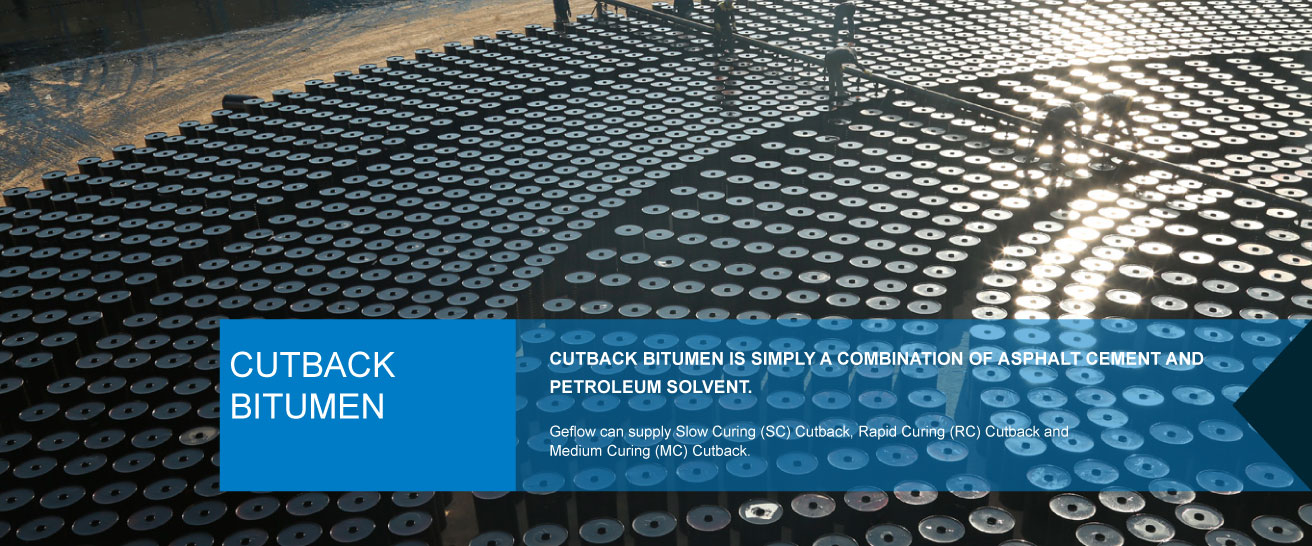
Cutback bitumen Slow Curing SC
The invention relates to bitumen cutback , in particular to the use of fatty acid esters as bitumen cutback agents. We describe These Slow Curing SC bitumen cutback agents may also as cutters, cutback additives, bitumen solvents, or bitumen thinners.
Cutback bitumen
Bitumen as a viscoelastic hydrocarbon, to be used to hold together mass in pavements. It`s highly viscous waterproof adhesive at ambient temperatures. Bitumen sourced from crude oil distillation. Also finds in natural deposits. One way to use bitumen in road pavements is to spray the bitumen at elevated temperatures onto the road pavement substrate and then to apply stone chips (generally single sized aggregates) to the bitumen surface.
This is variously known as bitumen spray sealing, bitumen seal coating, chip sealing or surface dressing. This can be contrasted with hot-mix or asphaltic concrete applications where bitumen and the aggregate are mixed together and then applied to a substrate. In cold-mix, cutback and mass are mixed at ambient temperatures. Some times kerosene and volatile products are added as cutter/cutback agent to bitumen to reduce asphalt viscosity.
Cutback asphalt
The reduction in viscosity of the Bitumen can aids the construction of seal coats in road pavements as the softened mixture wets the chips more easily. The cutback agent evaporates from the seal coat, the cutback agent becoming a negligible component of the seal coat a few months after application.
If major amounts of cutback agent remain in seal coat an unwanted long term softening effect may result.Cutback agents also uses to lower penetration bitumen viscosity, when it uses as primer to surface of road pavement mass base course or substrate. Primer penetrates to surface of base course and provides more bitumen friendly surface. Improved adhesion to base course of subsequently used seal coat or hot mix is catches. The primer may also serve to assist in waterproofing the base course layer.
We use Kerosene as a bitumen cutback Slow Curing SC agent at different concentrations according to local conditions and requirements. In Iran cutback bitumen for use in tar spray sealing or bitumen seal coating typically contains 2 to 5 % (w/w) of kerosene. 10-15 % kerosene may uses In cutback as primer.
There is many bugs with this use of kerosene for cutbacks. For example, the cutback bitumen is hazardous in use. Spray sealing or seal coating at 150 °C to 165 °C is well above the flash point of the cutback bitumen. In addition, evaporation of kerosene into the atmosphere is environmentally harmful. In Iran estimated 2000-4000 MT kerosene drops to environment yearly. Nasty smell emanating from cutback bitumen. Kerosene is taken from non-renewable resource.
Cutback bitumen Slow Curing SC agent
In order to address these disadvantages of conventional bitumen cutback agents, it is possible to use bitumen-water emulsions. After spray- application to the substrate the emulsion breaks and the water evaporates or runs off the surface. This process happens slowly (especially in cold weather or shaded areas) applied bitumen emulsion is vulnerable to wet weather until emulsion broken.
Heavy raining can washed from surface After using emulsion, before its broken, . This is more expensive. It also causes environmental damage as bitumen washed away and enters waterways.
Extender oil (fluxes) and wax also used in bitumen spray sealing and hot-mix. Fluxes and wax are distinct from cutback agents. Oil and wax uses to modify mechanical properties of used long time bitumen layers, increasing pavement life in some usages.
Extender oils and waxes remain as a component of the bitumen following application and setting of the seal coat or hot mix. The extender oils or waxes may simply solidify within the bitumen as the bitumen sets or may become cross-linked. Catalysts uses to promote crosslinking. However, these catalysts may also promote oxidation of the bitumen and an undesirable hardening. In some applications it is desirable to produce a seal coat with softer bitumen. Extender oils and waxes remain in bitumen after usage and setting of seal coat or hot mix and because this they uses. Object of invention to provide improved cut_back_bitumen agent, or provide public with a useful choice
General Definition of Cutback Bitumen SC-800
Cutback bitumen is a type of bitumen that is mixed with petroleum solvents. The solvents are usually called diluents or distillate. A more volatile solvent used will increase the rate of curing of the bitumen as they evaporate faster. The curing rate of a cutback bitumen is the basis of their classification: rapid curing, medium curing and slow curing. Slow curing cutback bitumen uses low volatility solvents generally in the heavy distillate range. Also, the amount of solvent used determines the viscosity of the cutback bitumen.
Cutback Bitumen Grade SC-800 is a slow curing cutback bitumen consisting of penetration grade bitumen blended with heavy solvent. They are often called road oils and are used primarily in road-mixing and dust-laying applications. Slow curing cutback bitumens are also used for stockpile patching mixes, plant-mixed with graded aggregates and occasionally for priming.
Our SC-800 Cutback Bitumen is complies with the ASTM D2028-97 standards for construction and treatment of pavements.
Application of Cutback Bitumen SC-800
Common use of a slow curing cutback bitumen are for stockpile patching mixes. Cutback bitumen used in mixing with aggregate will usually contain an adhesion agent to assist in the coating of the aggregate surface. Another use is as a prime coat and cold-applied as it don’t require any thinning and heating, thus saves time. Other than that Grade SC-800 Cutback Bitumen is also applied to waterproof a surface, to plug voids and to coat and bond loose mineral particles.
Packing of Cutback Bitumen Grade SC-800
Our packing options depends on our client’s needs. It can come in bulk (in tanker) or in new thick steel drums on pallet.
Definition of Cutback Bitumen SC-250
Cutback bitumen is a type of bitumen that is mixed with petroleum solvents. The solvents are usually called diluents or distillate. A more volatile solvent used will increase the rate of curing of the bitumen as they evaporate faster. The curing rate of a cutback bitumen is the basis of their classification: rapid curing, medium curing and slow curing. Slow curing cutback bitumen uses low volatility solvents generally in the heavy distillate range. Also, the amount of solvent used determines the viscosity of the cutback bitumen.
Cutback Bitumen Grade SC-250 is a slow curing cutback bitumen consisting of penetration grade bitumen blended with heavy solvent. They are often called road oils and are used primarily in road-mixing and dust-laying applications. Slow curing cutback bitumens are also used for stockpile patching mixes, plant-mixed with graded aggregates and occasionally for priming.
Our SC-250 Cutback Bitumen is complies with the ASTM D2028-97 standards for construction and treatment of pavements.
Application of Cutback Bitumen SC-250
Common use of a slow curing cutback bitumen are for stockpile patching mixes. Cutback bitumen used in mixing with aggregate will usually contain an adhesion agent to assist in the coating of the aggregate surface. Another use is as a prime coat and cold-applied as it don’t require any thinning and heating, thus saves time. Other than that Grade SC-250Cutback Bitumen is also applied to waterproof a surface, to plug voids and to coat and bond loose mineral particles.
Packing of Cutback Bitumen Grade SC-250
Our packing options depends on our client’s needs. It can come in bulk (in tanker) or in new thick steel drums on pallet.
Definition of Cutback Bitumen SC-70
Cutback bitumen is a type of bitumen that is mixed with petroleum solvents. The solvents are usually called diluents or distillate. A more volatile solvent used will increase the rate of curing of the bitumen as they evaporate faster. The curing rate of a cutback bitumen is the basis of their classification: rapid curing, medium curing and slow curing. Slow curing cutback bitumen uses low volatility solvents generally in the heavy distillate range. Also, the amount of solvent used determines the viscosity of the cutback bitumen.
Cutback Bitumen Grade SC-70 is a slow curing cutback bitumen consisting of penetration grade bitumen blended with heavy solvent. They are often called road oils and are used primarily in road-mixing and dust-laying applications. Slow curing cutback bitumens are also used for stockpile patching mixes, plant-mixed with graded aggregates and occasionally for priming.
Our SC-70 Cutback Bitumen is complies with the ASTM D2028-97 standards for construction and treatment of pavements.
Application of Cutback Bitumen SC-70
Common use of a slow curing cutback bitumen are for stockpile patching mixes. Cutback bitumen used in mixing with aggregate will usually contain an adhesion agent to assist in the coating of the aggregate surface. Another use is as a prime coat and cold-applied as it don’t require any thinning and heating, thus saves time. Other than that Grade SC-70 Cutback Bitumen is also applied to waterproof a surface, to plug voids and to coat and bond loose mineral particles.
Packing of Cutback Bitumen Grade SC-70
Our packing options depends on our client’s needs. It can come in bulk (in tanker) or in new thick steel drums on pallet.
Definition of Cutback Bitumen SC-30
Cutback bitumen is a type of bitumen that is mixed with petroleum solvents. The solvents are usually called diluents or distillate. A more volatile solvent used will increase the rate of curing of the bitumen as they evaporate faster. The curing rate of a cutback bitumen is the basis of their classification: rapid curing, medium curing and slow curing. Slow curing cutback bitumen uses low volatility solvents generally in the heavy distillate range. Also, the amount of solvent used determines the viscosity of the cutback bitumen.
Cutback Bitumen Grade SC-30 is a slow curing cutback bitumen consisting of penetration grade bitumen blended with heavy solvent. They are often called road oils and are used primarily in road-mixing and dust-laying applications. Slow curing cutback bitumens are also used for stockpile patching mixes, plant-mixed with graded aggregates and occasionally for priming.
Our SC-30 Cutback Bitumen is complies with the ASTM D2028-97 standards for construction and treatment of pavements.
Application of Cutback Bitumen SC-30
Common use of a slow curing cutback bitumen are for stockpile patching mixes. Cutback bitumen used in mixing with aggregate will usually contain an adhesion agent to assist in the coating of the aggregate surface. Another use is as a prime coat and cold-applied as it don’t require any thinning and heating, thus saves time. Other than that Grade SC-30 Cutback Bitumen is also applied to waterproof a surface, to plug voids and to coat and bond loose mineral particles.
Packing of Cutback Bitumen Grade SC-30
Our packing options depends on our client’s needs. It can come in bulk (in tanker) or in new thick steel drums on pallet.
